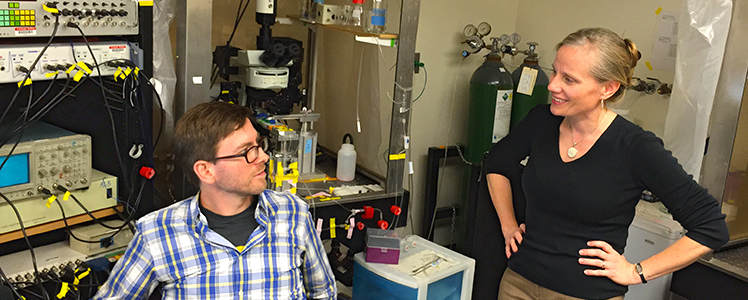Thursday, October 16, 2014

Alison Barth and Marcel Bruchez Awarded Kaufman Grant to Study Neural Communication in the Cerebral Cortex
This year, Alison Barth, professor of biological sciences, and Marcel Bruchez, associate professor of biological sciences and chemistry, were grant recipients of The Charles E. Kaufman Foundation, part of The Pittsburgh Foundation. In its second year as a grantmaking program, the foundation supports cutting-edge scientific research at institutions across Pennsylvania with annual award funding to new investigator and new initiative research.
“Mr. Kaufman’s vision was to use the power of research to drive innovations for humankind,” said Molly Beerman, The Pittsburgh Foundation’s Interim President and CEO. “His fund at The Pittsburgh Foundation has made great strides in reaching this lofty goal in just two short years, delivering much needed support to researchers at a time where other traditional funding sources have declined.”
Barth and Bruchez were awarded $300,000 over two years for research on “Neural Circuitry of the Mammalian Neocortex”. In studying how neurons communicate in the cerebral cortex, they propose to “develop and employ a novel protein complementation strategy to chemically tag synapses defined by pre- and post-synaptic cell identity.”
As collaborators for several years working with fluorescence-activated proteins (FAPs) to monitor protein interactions and trafficking, Bruchez developed a FAP-based protein complementation assay that Barth saw as a method to solve a larger neuroscience problem.
“How can we visualize whether two cells are synaptically connected to each other?” Barth said. “Other methods to do this are very slow and time-consuming – using small microelectrodes to ask whether cells are electrically connected – or where the fluorescence signals generated are too weak to be seen without substantial amplification.”
Moreover, previous approaches to tackling this problem have led to skewed results, where synaptic connections that should not appear are stabilized or even generated as a result of the experiments.
“The method that we’re trying to develop will enable to see synapses without signal noise, and without inadvertently stabilizing connections that shouldn’t be there,” Barth explained. “We’ll be able to visualize these connections in living tissue, without signal amplification.”
The long-term goal of this research is the development of a complete directory of cell-type specific synaptic connections, which would be the first of its kind.
“This is the first time that anyone has been able to do this,” Barth said. “I’m really excited about the data we’ll be able to collect.”